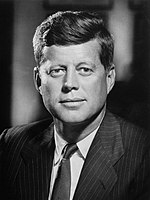1960_United_States_presidential_election_in_Virginia
1960 United States presidential election in Virginia
Election in Virginia
The 1960 United States presidential election in Virginia took place on November 8, 1960. Voters chose 12 representatives, or electors to the Electoral College, who voted for president and vice president.
For six decades Virginia had almost completely disenfranchised its black and poor white populations through the use of a cumulative poll tax and literacy tests.[1] So restricted was suffrage in this period that it has been calculated that a third of Virginia’s electorate during the first half of the twentieth century comprised state employees and officeholders.[1]
This limited electorate allowed Virginian politics to be controlled for four decades by the Byrd Organization, as progressive “antiorganization” factions were rendered impotent by the inability of almost all their potential electorate to vote.[2] Historical fusion with the “Readjuster” Democrats,[3] defection of substantial proportions of the Northeast-aligned white electorate of the Shenandoah Valley and Southwest Virginia over free silver,[4] and an early move towards a “lily white” Jim Crow party[3] meant Republicans retained a small but permanent number of legislative seats and local offices in the western part of the state.[5]
In 1928, the GOP did carry the state’s presidential electoral votes due to anti-Catholicism against Al Smith in the Chesapeake Bay region and increased middle-class Republicanism in the cities,[6] but it was 1952 before any real changes occurred, as in-migration from the traditionally Republican Northeast[7] meant that growing Washington, D.C., and Richmond suburbs would turn Republican not just in presidential elections but also in Congressional ones,[8] although the Republicans would not make significant gains in the state legislature. Opposition to the black civil rights legislation of Harry S. Truman meant that the Byrd Organization did not support Adlai Stevenson II,[9] with the result that Dwight D. Eisenhower carried the state aided by defections of the Southside Thurmond vote from 1948.[10] In 1956, Eisenhower repeated his win despite losing his Southside support due to the President’s opposition to Byrd’s “Massive Resistance” policy following Brown v. Board of Education,[11] as continuing Northern in-migration and a rapid swing to him of the modest but growing number of black voters allowed him to maintain his margin.[12]
In the following years, continuing “Massive Resistance” weakened the GOP in Virginia, as they could not develop a consistent or coherent response: Ted Dalton, who had received 45 percent of the vote in 1953 running against the Byrd Organization, won only 36 percent as his policy of “token integration” was drowned out by the state Democrats.[13]
Although Byrd again refused to endorse Democratic nominee, Senator John F. Kennedy, his former ally before the end of “Massive Resistance”, Governor J. Lindsay Almond, strongly endorsed the Massachusetts Senator against the Republican nominee, incumbent Vice President Richard Nixon.[14]


